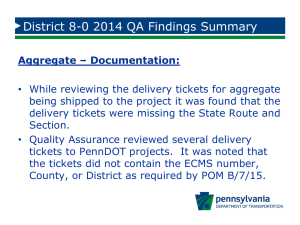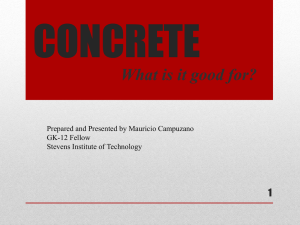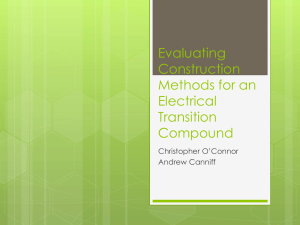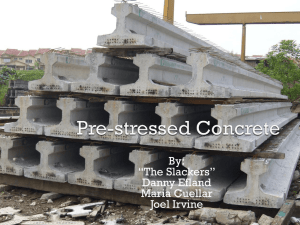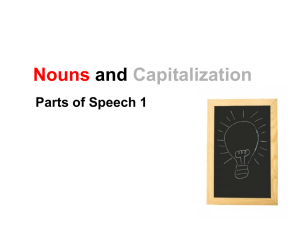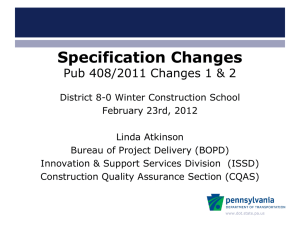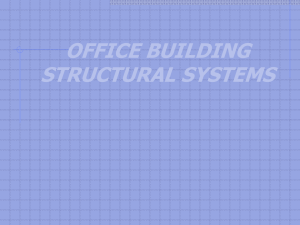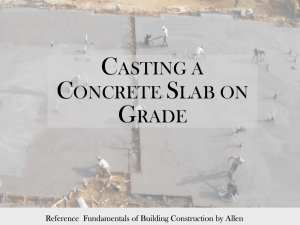casting ac
advertisement
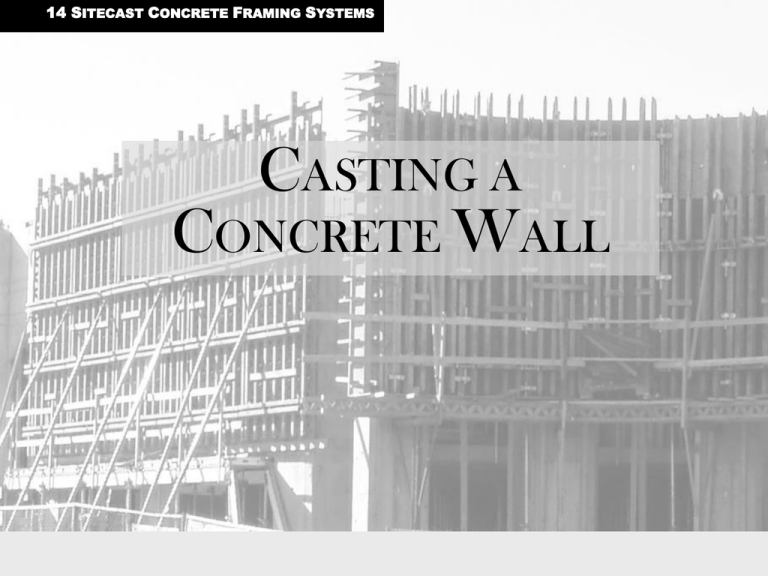
14 SITECAST CONCRETE FRAMING SYSTEMS CASTING A CONCRETE WALL CASTING A CONCRETE WALL Wall Footing • Concrete walls are most commonly cast over concrete strip footings. • The steel reinforcing projecting from the footing will overlap with reinforcing in the wall, to structurally tie the two elements. Fundamentals of Building Construction, Materials & th CASTING A CONCRETE WALL Reinforcing • The size, spacing, and arrangement of reinforcing bars varies with the structural requirements of the wall. • Typically, reinforcing is placed in one or two layers of vertical and horizontal reinforcing bars. Fundamentals of Building Construction, Materials & th CASTING A CONCRETE WALL Reinforcing • Reinforcing for a concrete shear wall (designed to resist lateral forces such as wind or earthquake), consisting of two layers of vertical and horizontal bars. • The wall is reinforced more heavily at either end, where it must resist greater stresses. CASTING A CONCRETE WALL Reinforcing • Heavy reinforcing at the base of concrete shear walls for a large, multistory building CASTING A CONCRETE WALL Wall Forms • Slender rods, called form ties, hold the forms in position and resist the outward pressure of the concrete when it is placed. • The plastic cones prevent the formwork for sliding along the ties, and form a neat, conical hole in the finished surface of the concrete. CASTING A CONCRETE WALL Wall Forms • Form ties can be made from steel rods (top), straps (bottom), wire, fiberglass, or other plastics. CASTING A CONCRETE WALL Wall Forms • After the wall is cast and the forms removed, the protruding ends of the metal ties are broken off and the plastic cones removed. CASTING A CONCRETE WALL Wall Forms • The remaining holes in the concrete may be left open, filled with mortar (right), or plugged with some other material. • If the broken end of a metal form tie rod is not covered, rust staining may result as the end of the tie gradually corrodes. • Fiberglass form tie rods may be used without plastic cones. The protruding ends of the rods are simply ground off flush with the face of the concrete, becoming virtually unnoticeable to the untrained eye. CASTING A CONCRETE WALL Wall Forms • Right: On the outside, the form ties engage with slotted metal wedges. The wedges restrain the horizontal walers. • The walers (and sometimes vertical studs) brace the formwork panels. CASTING A CONCRETE WALL Wall Forms • Wall forms must be constructed sufficiently stiff to resist the fluid pressures of the freshly poured concrete. • Right: A proprietary, modular wall form system, that can be easily raised and reused as wall construction proceeds upwards. • Note the temporary scaffolding integrated into the form system, providing workers with access to the top of the wall. CASTING A CONCRETE WALL Wall Forms • Heavy, braced formwork for a large, free-standing concrete wall. Fundamentals of Building Construction, Materials & th CASTING A CONCRETE WALL Wall Forms • Self-climbing formwork relies on hydraulic jacks to climb the concrete core structure as it is constructed. Fundamentals of Building Construction, Materials & th CASTING A CONCRETE WALL Pouring Concrete • Concrete is placed in the wall. • It is consolidated by vibrating or hammering on the sides of the formwork. • The of the wall is struck off level (right). • The top of the wall is covered to limit water loss, and the wall is left to cure. • After several days, the formwork may be stripped. Curing should continue for at least one week. Fundamentals of Building Construction, Materials & th CASTING A CONCRETE WALL Finishing the Concrete • A residential concrete foundation wall with the formwork stripped. • Without special efforts, the form panels and ties leave strong patterns on the wall surface. CASTING A CONCRETE WALL Finishing the Concrete • A concrete foundation wall with blockouts to create openings in the wall for passage of building services. CASTING A CONCRETE WALL Finishing the Concrete • Rough boards were used to line the inside of the wall forms, creating a board form finish on the cast wall. CASTING A CONCRETE WALL Finishing the Concrete • Poor quality formwork construction leads to defects in the concrete wall that do not become evident until the formwork is removed. Fundamentals of Building Construction, Materials & th CASTING A CONCRETE WALL Finishing the Concrete • Incomplete consolidation leads to a rock pocket in the concrete wall. • Note the exposed reinforcing bar. • Unsound concrete will be removed and the area patched. Fundamentals of Building Construction, Materials & th CASTING A CONCRETE WALL Controlling Cracking • Like slabs, concrete walls are susceptible to cracking due to concrete shrinkage during curing, thermal stresses, and other effects. • Vertical control joints, spaced at 24 to 30 times the thickness of the wall, can be formed in the wall to organize and conceal shrinkage cracks. • Full-depth expansion joints can also be inserted at larger spacings, if required. Shrinkage cracks in a concrete retaining wall highlighted by moisture migrating through the joints. Fundamentals of Building Construction, Materials & th CASTING A CONCRETE WALL Insulating Concrete Forms (ICF) • Concrete forms made from rigid plastic foam blocks or other lightweight insulating materials are easy to erect. • The forms become a permanent part of the structure, creating a more energy efficient wall in comparison to conventional concrete construction. Fundamentals of Building Construction, Materials & th CASTING A CONCRETE WALL Tilt-Up Construction • Concrete wall panels are poured lying flat, much like a slab on grade. • Once the panels have gained sufficient strength, they are lifted into final position. • Tilt-up construction significantly reduces formwork costs, which can account for 50 per cent or more of the cost of conventional concrete construction.

